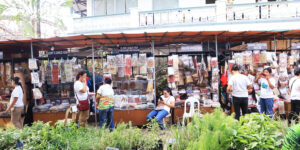
During my recent trip to Taiwan with family, one of the attractions that left an impression on me was the massive crowds at their night markets, which offered a wide variety of street food as well as shopping options, mostly for tourists, but I reckon it was also frequented by locals as well.
Being the type of travelers who don’t do tour groups, our intrepid party of four that consisted of two parents and two teenagers who had thankfully outgrown their fast food stage, did a lot of our eating (or was it technically grazing) trying different kinds of street food at the busy night markets of Taipei.
We experienced two night markets at their peak, the touristy one at the Ximending shopping district, which was within distance of our accommodations, and the one at Raohe which felt a bit more authentic, which I liked better in terms of street food choices. Our exploration of Taipei also led us to the Shilin night market, although it was off-peak and its occupants were just starting to stir into activity as they day had not yet officially turned into night.
In the night markets that we entered during peak hours, the crowds were massive. The most relatable way I could describe the number of people would be peak MassKara street party shoulder-to-shoulder crowds. And unless I was mistaken and we were there at a particularly busy time, this apparently happens all-year-round in those street markets. If that is the case, that is very impressive and it would be interesting to study how they were able to achieve this feat.
Ximending is basically a shopping district, so the night market stalls were sprinkled all along the alley that was lined with shops that featured local and international brands. Making it the most touristy among all the night markets that we saw were the street performers that had appropriated strategic intersections of the area. Another interesting thing we noticed in Taipei was the street performers/buskers all seemed to have ID’s or permits to perform, which is something we’ll discuss in another column.
The Raohe night market, where our local driver / tour guide dropped us off after a day trip to various destinations outside Taipei, gave a slightly more authentic night market vibe. This was where I joined a massive queue that stretched to the entrance of the market, for pepper pork buns (NTD 60 each) that were totally worth it. While I was in that queue, the kids got grilled and torched beef that was served in a paper bowl but cost NTD 300 (around PHP 600). We also got some corn and other street food items, and had our stand up dinner at the sidewalk.
Note that their street food prices, while affordable, wasn’t dirt cheap like here in the Philippines. For me this meant that their street food culture is more advanced than ours, which could also point to the success of their night/street markets. The food their vendors serve definitely has more variety, complexity and costs than our usual fishball, kikiam, kwek kwek, and inasal, which make up most of the food stalls whenever we have some kind of street market set up. In Taipei street markets, we found fried chicken the size of your face, different varieties of scallion pancakes and mochi balls, fruit, kamote, corn, beef, pork buns, milk tea, noodles, and rice toppings, just to name a few off the top of my overwhelmed head. The variety alone probably gives their night markets a better chance of success and sustainability, and along with better government regulations that ensures the safety of the food products peddled by their vendors, it could explain why their street markets are so much bigger.
Of course there were also illegal vendors, and we witnessed ourselves at Ximindeng how one old lady with a pushcart was being apprehended by cops. We didn’t have any way of knowing if those were operating like our kotong cops, but at least we saw signs of regulation and enforcement.
Before we came to Taipei, our party also dropped by and enjoyed the Salcedo weekend market in Makati and also enjoyed ourselves in that once-a-week, 8pm to 2pm market that featured a lot of different dishes offered by local and foreign expats in the community. I think we have our own Farmers weekend market at Magsaysay street which has somehow managed to survive the pandemic. The difference in between Taipei’s markets and ours, however, is staggering, and the organizers on our end have a lot of catching up to do if we want to achieve the same success in terms of weekend/street/night market culture which, if done right and sustainably, could be a boon to the local tourism scene and the economy.*







